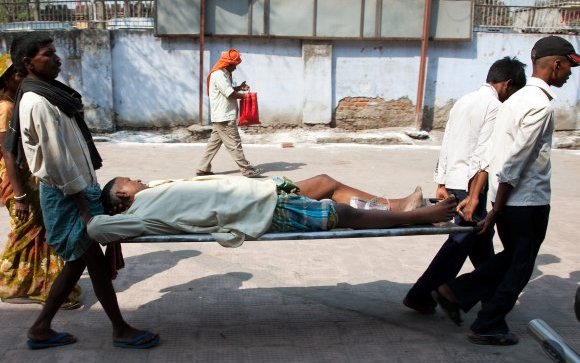A harmonised platform for visceral leishmaniasis drug-resistance research
The growing inefficacy of the drugs currently available to treat visceral leishmaniasis (VL) needs to be addressed with harmonised research procedures, in order to discriminate resistant and susceptible strains, and establish a resistance ‘breakpoint’.

A new article published in the journal Parasitology outlines a first tentative proposal to launch a harmonisation initiative.
There is a worryingly limited number of medicines currently available to treat visceral leishmaniasis (VL). As they have been employed to eliminate the disease, particularly in the Indian subcontinent, they have encountered resistance from the parasite, for reasons not always easily identifiable. In ‘Evaluating drug resistance in visceral leishmaniasis: the challenges’, Hendrickx and colleagues propose a harmonisation initiative to establish the causes of the emergence and spread of resistance and, based on that, inform the leishmaniasis community worldwide on the efficacy monitoring of the current antileishmanial drugs.
Prof Louis Maes, full professor at the University of Antwerp and senior author of the paper, says: “We need to undertake in-depth research into the factors affecting treatment efficacy, particularly identifying drug resistance mechanisms. Being able to provide molecular markers for ongoing resistance surveillance would enable physicians and the health community to adapt treatment policies and reduce VL morbidity and mortality.”
Leishmaniasis is one of the world’s most neglected tropical infectious diseases. The visceral form reportedly affects between 200,000 and 400,000 people, and kills 30,000 of them every year, the parasitic disease killing most people after malaria. Researchers believe the number is higher, due to underreporting and delayed diagnosis.
A high-scale effort to eliminate VL is under implementation in the Indian sub-continent, with liposomal amphotericin B (AmB) and miltefosine (MIL) adopted as the drugs of choice for first-line treatments. Until recently, high costs, limited availability and the requirement for cold chain facilities had restricted the use of AmB. MIL monotherapy was an effective and more affordable alternative, but the number of therapy failures has increased after ten years of implementation. Although no definite link with intrinsic drug resistance could be established, the use of MIL-monotherapy is now discouraged.
Researchers face a huge challenge in their quest to map resistance. Clinical isolates displaying resistance to MIL or AmB are still fairly scarce. As a result, fundamental and applied research on resistance mechanisms and dynamics remains largely dependent on laboratory-generated drug resistant strains – which is far from ideal, considering the genetic diversity linked to geographical background, among other limitations.
However, a lot of variations in drug susceptibility have already been described between strains from different geographical regions. To be of any scientific or practical use, they need to be processed through a reliable and reproducible method which would enable researchers to differentiate shifts in drug susceptibility and actual drug resistance within parasite populations from what is caused by the host pharmacokinetic and immunological factors.
“Even though an intensive search for easy-to-use molecular markers has been pursued during the last decade, we still do not have standard criteria and methodologies to unequivocally define a parasite’s drug susceptibility,” states Dr. Sarah Hendrickx from the University of Antwerp, and first author of the article. “The pivotal role of the patient (immunity, genetic background, co-infections, etc.) in post-treatment relapses should not be overlooked either.”
The authors propose a task force to join VL experts from academia, diagnostic laboratories and the clinical and public health sectors with groups who have pioneered similar programmes in malaria and microbial infections, in order to establish acceptable levels of harmonisation and uniformity among laboratories. Such a task force, the article highlights, should draw on the successful practices of the WorldWide Antimalarial Resistance Network (WWARN), which is part of the Infectious Diseases Data Observatory (IDDO).
Prof Philippe Guérin, director of IDDO and co-author of the paper states: “WWARN developed a unique model to facilitate individual patient data sharing and engaged over 260 partners around the world, including research institutions, governmental and non-governmental organisations, product development partnerships and pharmaceutical companies. The collective efforts of WWARN collaborators have improved our understanding of the factors affecting the efficacy of currently used antimalarial medicines and informed policy changes.” The authors suggest that the leishmanial research community launch a “similar action plan” to support the elimination of VL as a public health priority.
“Monitoring and surveillance of drug sensitivity and resistance are essential to safeguard current treatment options and to establish models for the introduction of new drugs in the future. To discriminate resistant and susceptible strains, a clear definition of drug resistance with establishment of resistance ‘breakpoints’ is definitely needed,” the article concludes.
Publication details
Hendrickx, S., Guerin, P., Caljon, G., Croft, S. and Maes, L. (2016) ‘Evaluating drug resistance in visceral leishmaniasis: the challenges’, Parasitology, pp. 1–11. doi: 10.1017/S0031182016002031.
The full article can be download as pdf here and its Supplemental Material can be downloaded here.

